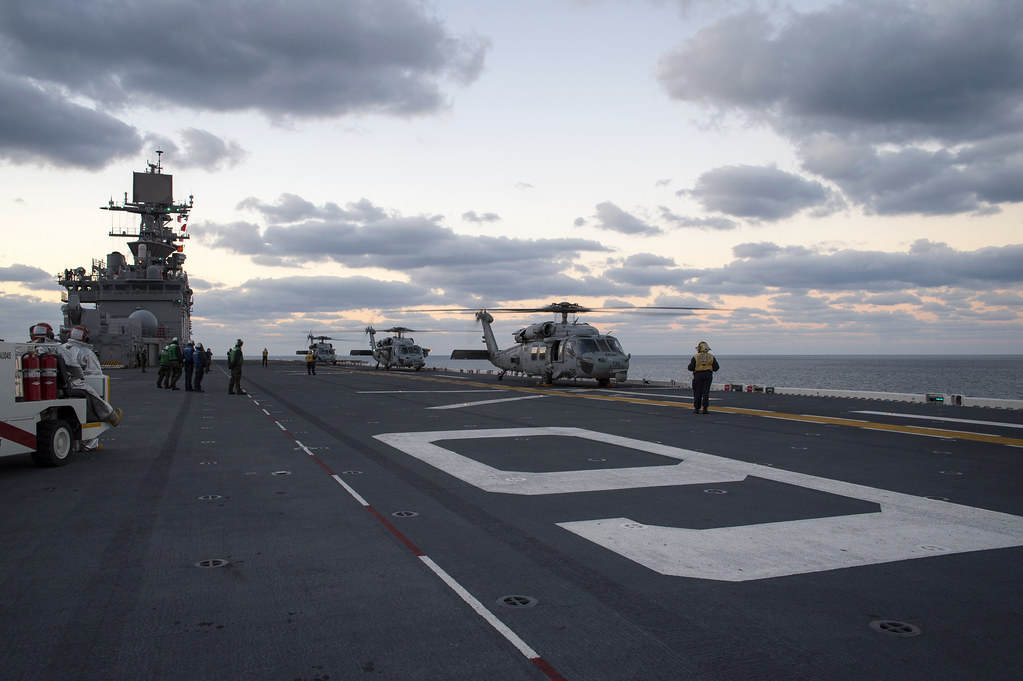By MC2 Diana Quinlan, USS Bonhomme Richard Public Affairs
MH-60S Sea Hawks assigned to Helicopter Sea Combat Squadron (HSC) 25 prepare to depart USS Bonhomme Richard (LHD 6), Feb. 13. (U.S. Navy/MC3 William Sykes) >>
SASEBO, Japan - Amphibious assault ship USS Bonhomme Richard (LHD 6) returned to Sasebo, Japan, after completing unit-level training with Afloat Training Group Western Pacific (ATGWP), Feb. 13.
Above and below decks, Sailors and Marines worked hard to meet the goals set in front of them, whether it was launching AV-8B Harriers on the flight deck or keeping the ship’s boilers lit deep inside machinery rooms.
“Out at sea, ship’s readiness and operability are the responsibility of all hands,” said Capt. Jeffrey Ward, USS Bonhomme Richard, commanding officer. “During this short underway, our Sailors have completed monumental tasks ranging from engineering and firefighting drills to flight deck certifications. I am immensely proud of each and every Sailor aboard and the job that they do.”
The ship’s Damage Controlmen (DC) conducted DC University courses, training and qualifying Sailors on board in basic and advanced firefighting techniques, in addition to undergoing daily drills. Air department kept busy making sure that BHR’s flight deck is maintained in top quality conditions for the Harriers of Marine Attack Squadron (VMA) 311 “Tomcats” and MH-60S Sea Hawks from Helicopter Sea Combat Squadron (HSC) 25, while high above the flight deck, navigation department attained certified in ship’s navigation and security paired up with weapons department to conduct daily small arms training and qualifications during day and low-light shooting evolutions, qualifying approximately 150 Sailors.
In the midst of unit-level training throughout the ship, engineering department maintained the busiest schedule of all, completing more than 240 evolutions and more than 80 drills within a two week period, said Senior Chief Electrician’s Mate Neil Guan, from Long Beach, Calif., ATG senior team leader.
Each evolution and drill was monitored and assessed by ATG members, who provided feedback and instruction on corrective actions if necessary. Additionally, daily safe-to-operate walkthroughs were conducted to ensure that the areas were safe to train in.
“Our main purpose here was to make sure that the ship is ready for engineering certification,” said Guan. “There are several stages before the grading evolution, and we are trying to make sure that engineering department hits the mark. We were looking at two categories - regular and infrequent evolutions.”
According to Guan, evolutions that fall under infrequent consist of shafting drills, major fuel leaks, class Bravo fires and re-entries into main spaces, whereas regular evolutions include shifting lube oil strainers, conducting three-point checks on the engines and stopping and locking the shaft.
“We started this float with two inexperienced watch teams for engineering spaces, 11 people per team, and for some of them it was their first watch,” said Machinist’s Mate 1st Class Francisco Ceja, from Richmond, Calif. “We went from zero-experience watchstanders, not being able to pass one evolution or drill, to meeting the numbers required by ATG in two weeks. Stateside, ships get five to six months to train in order to certify. We did it in two weeks.”
According to Guan, Bonhomme Richard’s engineering team made great progress.
“For the engineering team, it has been a great improvement from day one, and I hope they will continue to perform at this high level,” said Guan. “The next step will be Engineering Assessment Pacific (EAP) conducted by the officers. Our grading criterion is higher than theirs in order to make sure that the ship is ready for certification. By the time they are on board, we want the ship’s performance to be at a level that will blow them away, certifying engineering for the next two years.”
Machinist’s Mate 1st Class Jacob Soto, from San Antonio, Texas, said he was proud of the team’s accomplishments and shared in the excitement of coming home.
“We were receptive to all the feedback from ATG, and I think, that is what made us better,” said Soto. “Now, it feels great to get home after accomplishing so much in such a short time. Everyone is happy. But at the same time, we still have a lot of work to do in preparations for our next deployment and graded certifications, which I am confident we will be more than ready for.”

